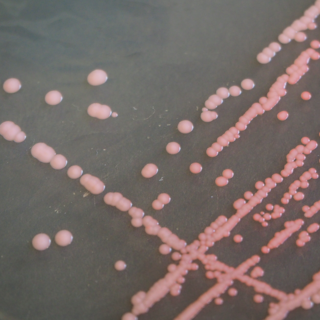Herminiimonas glaciei is a species of ultramicrobacterium in the family Oxalobacteraceae. These small gram-negative cells have a variable number of long flagella at the ends and sides of their rod-shaped bodies. With dimensions of 0.5–0.9 by 0.3–0.4 µm, H. glaciei is roughly 10 to 50 times smaller than Escherichia coli. Discovered in 2009, the species was isolated from 120,000 years old glacial ice, 3,042 metres (1.9 mi) deep, from Greenland. It was revived after a long-term incubation—seven months of oxygen-free growth at 2 °C, followed by growth on agar plates at 5 °C for almost five months. DNA sequence analysis suggests that with a sequence similarity of 99.6%, H. glaciei is most closely related to H. saxobsidens, a species originally isolated from lichen-colonized rock. Loveland-Curtze, head of the team of scientists from Pennsylvania State University who found the species, speculates that it may offer insight into the existence of organisms in extraterrestrial habitats.

Hanseniaspora is a genus of yeasts. The name Kloeckera is applied to its anamorph form. They are typically apiculate (lemon-shaped) in shape and often found in grape musts pre-fermentation.
Sporobolomyces koalae is a species of fungus in the order Sporidiobolales. It is an anamorphic yeast. Strains of the yeast were isolated from nasal swabs from three of five captive Queensland koalas kept at the Kobe Oji Zoo in Kobe, Japan. Swabs from three zoo keepers were examined as well, but tested negative for the presence of the yeast. It is not suspected to be pathogenic, as the koalas from which it was isolated were healthy.
Hanseniaspora guilliermondii is a species of yeast in the family Saccharomycetaceae. In its anamorph form, it is called Kloeckera apis.
Haloferax larsenii is a gram-negative, aerobic, neutrophilic, extremely halophilic archaeon. It was named in honor of Professor Helge Larsen, who pioneered research on halophiles.
Aspergillus marvanovae is a species of fungus in the genus Aspergillus which has been isolated from water with high boracic acid anions from the Dukovany nuclear power station in the Czech Republic. It is from the Fumigati section. Several fungi from this section produce heat-resistant ascospores, and the isolates from this section are frequently obtained from locations where natural fires have previously occurred. The species was first described in 2014. Aspergillus marvanovae produces apolar indoloterpenes.
Dokdonia is a genus of bacteria in the family Flavobacteriaceae and phylum Bacteroidota.
Propionispira raffinosivorans is a motile, obligate anaerobic, gram-negative bacteria. It was originally isolated from spoiled beer and believed to have some causative effect in beer spoilage. Since then, it has been taxonomically reclassified and proven to play a role in anaerobic beer spoilage, because of its production of acids, such as acetic and propionic acid, during fermentation

Deferrisoma camini is a moderately thermophilic and anaerobic bacterium from the genus of Deferrisoma which has been isolated from a deep-sea hydrothermal vent from the Eastern Lau Spreading Centre in the Pacific Ocean.
Kazachstania yasuniensis is a recently isolated yeast. This organism is part of the genus Kazachstania, which can be found in a large variety of habitats such as fermented foods, animals, wastewater, et cetera.
Blastobotrys elegans is a species of fungus.

Arthrobacter bussei is a pink-coloured, aerobic, coccus-shaped, Gram-stain-positive, oxidase-positive and catalase-positive bacterium isolated from cheese made of cow´s milk. A. bussei is non-motile and does not form spores. Rod–coccus life cycle is not observed. Cells are 1.1–1.5 µm in diameter. On trypticase soy agar it forms pink-coloured, raised and round colonies, which are 1.0 mm in diameter after 5 days at 30 °C The genome of the strain A. bussei KR32T has been fully sequenced.
Ornithinibacter aureus is a species of Gram positive, nonmotile, non-sporeforming bacteria. The bacteria are aerobic and mesophilic, and the cells are irregular rods that form branching hyphae. The species was first described in 2011, and it was originally isolated from surface seawater collected from the South China Sea. The species name is derived from Latin aureus (golden), referring to the yellow-pigmented colonies that form on R2A agar. O. aureus is the type species of genus Ornithinibacter, and is currently the only species in the genus.
Hanseniaspora lachancei is a species of yeast in the family Saccharomycetaceae. It is associated with fermenting agave juice and a tequila production facility in Mexico.
Hanseniaspora opuntiae is a species of yeast in the family Saccharomycetaceae. It has been isolated from locations worldwide, on grape berries and on prickly pear cacti.
Hanseniaspora meyeri is a species of yeast in the family Saccharomycetaceae. Samples of the species have been obtained worldwide from flowers, fruit flies, stem rot, and spoiled grape punch.
Hanseniaspora occidentalis is a species of yeast in the family Saccharomycetaceae. In its anamorph form, it was called Kloeckera javanica. It has been isolated in the wild from soil samples and vineyards. Samples of a variant have been isolated from orange juice and rotten oranges. It has demonstrated potential as an organism to reduce malic acid in wine production.
Hanseniaspora gamundiae is a species of yeast in the family Saccharomycodaceae. It has been isolated from the fruiting bodies of Cyttaria hariotii mushrooms in Patagonia and is likely responsible for the early stages of fermentation of an alcoholic chicha produced from the mushrooms.
Hanseniaspora osmophila is a species of yeast in the family Saccharomycetaceae. It is found in soil and among the bark, leaves, and fruits of plants, as well as fermented foods and beverages made from fruit.
Hanseniaspora pseudoguilliermondii is a species of yeast in the family Saccharomycetaceae. Originally isolated from orange juice concentrate, it has been found on fruit and fruit juices in locations around the world. It has also been observed forming hybrids with Hanseniaspora opuntiae.


